Whatcom County, Washington
Sphingidae Larvae
Smerinthus ophthalmica larvae, Ferndale, Washington, August 7, 2010, courtesy of Sabrina England.
|
|
Created/dedicated as per personal communication with Sabrina England, July-August 2010 Updated as per Butterflies and Moths of North America, formerly USGS, August 8, 2010 Updated as per James P. Tuttle's The Hawk Moths of North America, August 8, 2010 |
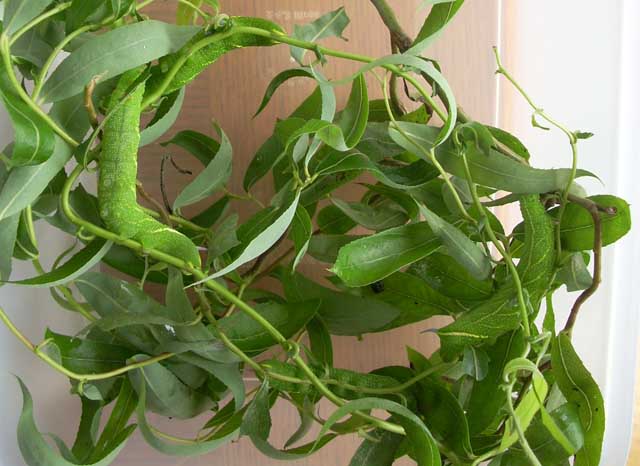
July 12, 2010
Sabrina writes, "I located your name online while searching for information about a moth that my daughter is presently holding in a butterfly treehouse.
We live in Ferndale, Washington, and her grandparents (my parents) found this moth in their backyard. Knowing that my daughter loves moths, they captured
it, and we brought it home. It has been in captivity for about 24 hours now, and I would typically insist that my daughter release it now, but we would
like your advice. It appears that SHE has laid eggs. (see pictures) However, they are stuck to the mesh sides of the treehouse, so I am worried about
hurting them as I pull them off. I was trying to put them in an airtight ziplock container as you suggest, but was only able to easily pull some of them
off. Should I stop or continue? Also, can you identify this moth for us? It has two distinct eyes on its wings when they are fully extended and there
are hints of pink. It looks somewhat similar to the polyphemus moth, but darker.
"Any advice is most appreciated."
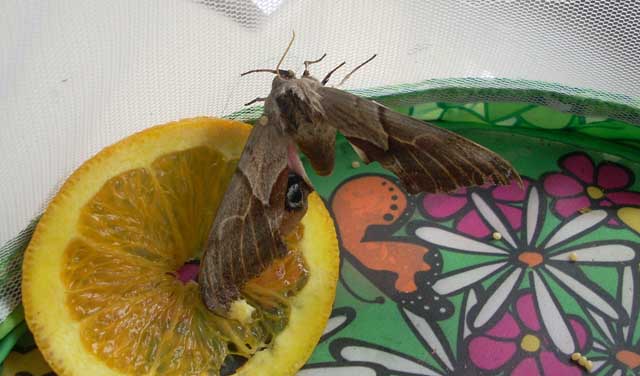
Smerinthus opthalmica female, Ferndale, Whatcom County, Washington,
July 12, 2010, courtesy of Sabrina England.
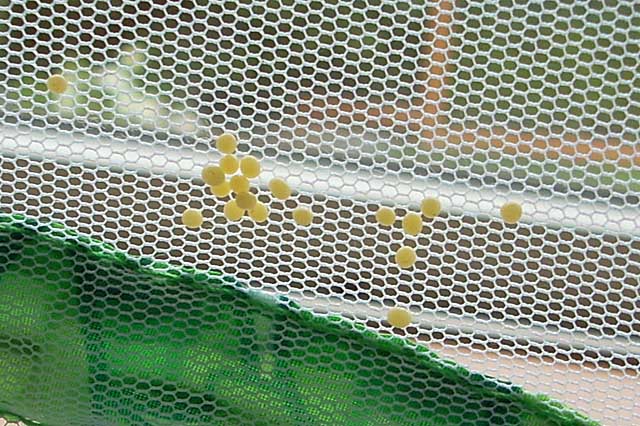
Smerinthus ophthalmica eggs, Ferndale, Whatcom County, Washington,
July 12, 2010, courtesy of Sabrina England.
"Yes, those are ophthalmica eggs. Release the moth. Egg shells will likely be tougher now than they were yesterday, and you should be able to roll most of them off without rupturing them so continue doing that. No need for fruit or moisture in with this species as they have no mouth parts, nor do they have a feeding tube. They live off fats stored from caterpillar days. Additional pics and info from the links on the page above. This species also flies here on PEI.
"Best of luck with them.
"Also read http://www.silkmoths.bizland.com/Actiaslunarearing.htm.
"Same principles apply.
"This (S. ophthalmica) is an easy species to rear also."
July 20, 2010 2:04 AM: Day 8 & we have hatchlings!
Sabrina writes, "Now we really need your advice! I think I have read
your webpage about feeding and caring for the hatchlings at least five times,
but what I am not clear on is how much space these little (soon to get
bigger) hatchlings need. Right now they are in a small container, but I am
predicting that we'll have at least 20 hatchlings by the time they are
done. I think our container is not adequate. Would they be better off
being released on a nice willow tree somewhere outside? (Not my willow
tree, mind you!) Or, maybe a big, old cherry tree? I can find
something in a remote location, and the weather is mild this week... no rain,
not too hot, not too cool. We have done the butterfly rearing (from the
caterpillar stage), so I'm okay with not watching it this time. I
think I'm intimidated by their eventual size and numbers! Or, do you
think we need to finish what we have started here, and provide appropriate food
and containment?"
I replied, "Three to six of them would likely be quite manageable in a gallon jar.
Release the rest or all of them on poplar or willow."
August 07, 2010 3:00 PM; Our caterpillars have grown!
Sabrina writes, "Just wanted to give you an update on our moth rearing. The caterpillars are big and fat! The stems are from my willow tree, and we have
found that they like that best. They didnít really care for the cherry. One more question I have is, what do we do to facilitate their cocooning? Do
they need anything different in the container? How and where do they attach themselves, or will I just find them on the branches and stems as I do now?"
I replied, "Congratulations on success so far. These caterpillars are members of the Sphingidae family. They do not spin silken cocoons
like the luna moths.
"Under natural conditions, they would crawl or drop to ground when done feeding and then excavate subterranean chambers in which to pupate and spend the
winter.
"There are instructions for care of prepupal larvae on the Smerinthus cerisyi file.
"I would like permission to post your image of larvae, credited to you, to Whatcom County larva thumbnail that I will create? Please send it or larger
individual pictures as jpg attachments.
"I would also like permission to include our back and forth communication on the page as it may help others who find female moths and wish to rear larvae?"
Sabrina replied, "Yes, you may use any of our correspondence or my pictures on your site! Attached are some of our recent photos.
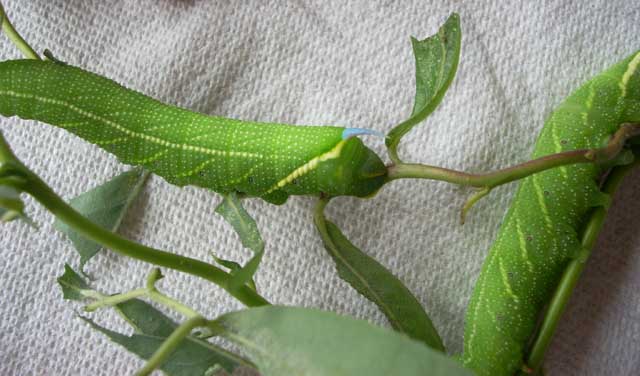
"Unfortunately, I have been reading about rearing silk moths over the last month, but I just located the more appropriate rearing instructions for the Smerinthus ophthalmica. You say in 3-4 week they will leave the food. Ours hatched 20 days ago. Will it be an unmistakable event when they ďleaveĒ the food? Or should I just give them the appropriate medium sometime this week without their prompting? Also, what about the frass? Presently, Iím cleaning it out about twice a day (every morning and every night). Am I disturbing them too much for them to begin this process?"
I responded, "As long as you have foodplant in the container with the larvae, their departure from the foodplant should be quite evident.
Instead of clinging to a stem and feeding, they will be crawling around the bottom of the container (often at great speed initially) and will no longer
show any interest in the foodplant.
``You can put the ones that have left the foodplant in a sandwich sized tupperware or gladware type plastic container, five or six to a container, lid on
tight and no air holes.
There should be a folded paper towel on bottom of plastic tub. Within a day or so they will crawl under the towelling or between the folds.
"The paper towel will become limp as it absorbs some of the moisture from the "sweating" larvae. This is natural and there will be some shrinkage to the larvae.
They will have stopped crawling and their legs will become quite stumpy in preparation for pupation, which they should do within four to six days of leaving the foliage.
"Cleaning the frass out of the rearing container once a day should be sufficient. This species is very hardy and you wil not be disturbing them too much is you are cleaning frass twice a day.
"They might thrash about quite a bit when you first pick them up, so do not be alarmed.
"I suspect they will leave the foliage some time this week."
"For the record, they left the foodplant at about 23-25 days."
"Normally Smerinthus ophthalmica produces a single brood each year so I do not anticipate that any will hatch between now and October 1.
"When you go to place them into cold storage in October, they can all be placed in one tub. By that time or before, there may be some mildew on the paper
towels. The paper towels can be replaced at any time by fresh towels, but if you replace the towels, replace the moisture with one or two drips of water.
"In nature they would normally be at rest under leaf litter or in shallow subterranean chambers where there is usually some humidity."
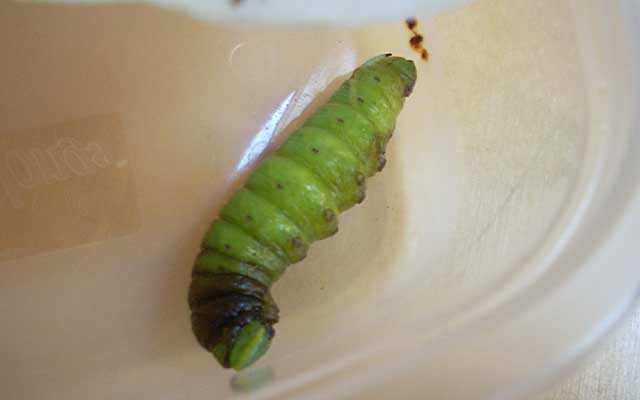
Smerinthus ophthalmica, Whatcom County, Washington, August 17, 2010, courtesy of Sabrina England.
"Just hope the others are not sick. Sometimes there is a late virus that
sets in. There is no treatment."
"Virus?! That would have never occurred to me, but I suppose all life is
susceptible to viruses of some sort. We looked at all of them late last
night. One of the larvae is nearly completely pupated, with a brown
shell-like appearance. I think that was the one that left the food
first. The other 3 all look very similar to the one I sent the picture
of. I'll check on them again this evening to see if there is any
change.
"Keeping my fingers crossed."
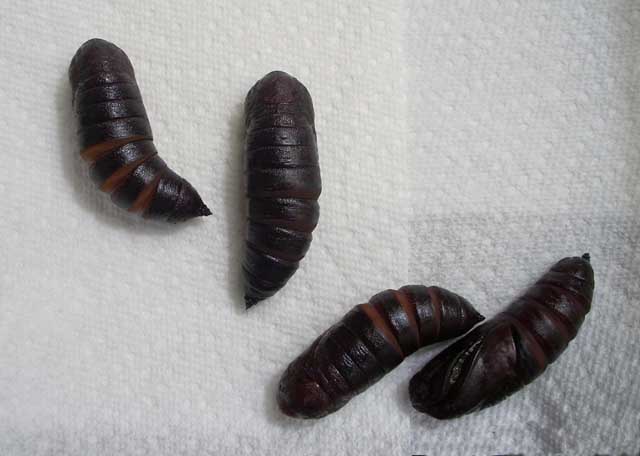
Smerinthus ophthalmica pupae, Whatcom County, Washington, August 20, 2010, courtesy of Sabrina England.
"Congratulations. I do not know what will become of the one on the far right. Seems to be a bit of a deformity in the pupal shell."
For care of "found larvae/caterpillars" visit Manduca sexta larva, Travis County, central Texas, August 21, 2008, Trina Woodall.
Only seventeen Sphingidae species are listed for Washington on the U.S.G.S. website. Not all of the species are reported or anticipated in Whatcom County (Five are reported on U.S.G.S. as of August 8, 2010: Modest sphinx (Pachysphinx modesta) more likely Pachysphinx occidentalis; Blinded sphinx (Paonias excaecata); One-eyed sphinx (Smerinthus ophthalmica); Bedstraw hawkmoth (Hyles gallii); White-lined sphinx (Hyles lineata). It is hoped that this checklist, with the thumbnails and notes, will help you quickly identify the larvae you are likely to encounter. A "WO" after the species name indicates that I have no confirmed reports of this species in your county, but I (William Oehlke) expect that this moth with its larvae are present or might be present. I have included many species not on the USGS list for Washington; I believe they are or might be present
A "USGS" indicates the moth is reported in Lepidoptera of North America, #1. Distribution of Silkmoths (Saturniidae) and Hawkmoths (Sphingidae) of Eastern North America, an excellent little booklet available through Paul Opler.
Please help me develop this list with improved, documented accuracy by sending sightings (species, date, location), preferably with an electronic image, via email to Bill Oehlke.
Sphinginae subfamily
Smerinthini Tribe:
Macroglossinae subfamilyDilophonotini tribe:
Macroglossini tribe:
|
Enjoy some of nature's wonderments, giant silk moth cocoons. These cocoons are for sale winter and fall. Beautiful Saturniidae moths will emerge the following spring and summer. Read Actias luna rearing article. Additional online help available.
Use your browser "Back" button to return to the previous page.
This page is brought to you by Bill Oehlke and the WLSS. Pages are on space rented from Bizland. If you would like to become a "Patron of the Sphingidae Site", contact Bill.
Please send sightings/images to Bill. I will do my best to respond to requests for identification help.
 Show appreciation for this site by clicking on flashing butterfly to the left. The link will take you to a page with links to many insect sites. |